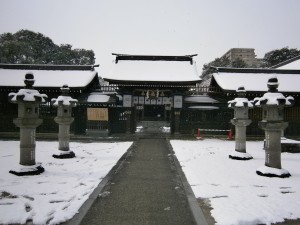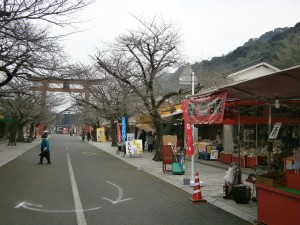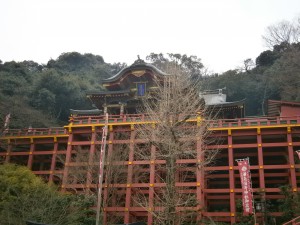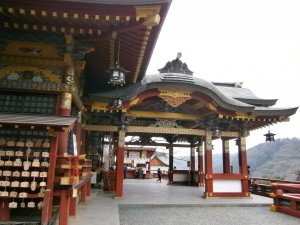“Saga’s not cold”, they said. “In fact, it has one of the mildest winters in Japan”, they said. You know that feeling you get when you drink a glass of water too soon after cleaning your teeth? Well, my whole body is rather minty fresh right now. This week has been a chilly one and Japanese architecture isn’t exactly built for heat retention. Single glazing in the snow has shot into my top 10 of things I don’t like, nestled between killer centipedes and stubbing my toe on things. Still, I guess I can’t complain. I’ve heard that Seoul this week is a sweltering -8 in the daytime.

In the interests of science, travel blogging and rolling around in the snow like a 5-year-old, I ventured out into the world to give you a taste of what there is to do around here. Don’t say I never do anything for you. I travelled far and wide, across moonlit deserts and steaming rainforests to bring you the best Saga has to offer. Well, not really. I just went to a shrine yesterday. I haven’t found too many deserts yet. Here’s what I found out:
The Yutoku Inari shrine is a Shinto complex in Kashima city, about half an hour from where I live. There are a whole bunch of different deities in Shinto, but this particular one is dedicated to the fox god. In fact, it’s the second biggest shrine to the fox god after Fushimi Inari, which is in Kyoto prefecture. If you’ve ever seen photos of loads of red Japanese gates stacked close together, that’s Fushimi. You also probably saw it on my Facebook, so I guess I should apologise. Anyway, Yutoku seems to be super proud of its size for some reason. Everywhere in Japan has to have something that makes it unique, even if it’s only that the town eats a disproportionate amount of Japanese sweets. The fox god, according to my brochure, is a ‘guardian deity of all aspects of life’, which sounds to me like a sly fox’s way of making money any time you think you need a prayer for something. I had a cold this week, so that was as good a reason as any to go. Maybe it’ll get rid of it for me if I write a nice review. Or give me a couple of million in a Swiss bank account. I’m not fussy.
Not too many foreign tourists go to Yutoku because it’s pretty out of the way. It’s about half an hour’s walk from the nearest station through some pretty deserted rice paddies. My friend and I even stocked up on food just in case, though the amount of sugar and fat in convenience food was far more likely to kill me than a period of solid exercise. It turned out to be unnecessary, as the approach to the shrine was filled with food stalls and shops selling statues and one-kilo bags of tea. It’s difficult to starve there, unless you don’t like battered octopus. I quite like battered octopus, as long as I don’t think too much about what the tentacles used to be attached to. Maybe I should retract my previous statement. It’s very easy to starve there.
The shrine itself was worth putting away the bag of crisps and getting out of my seat for. Most Japanese temples are understated and tranquil, exuding an air of refinement that makes you feel self-important and bohemian for the rest of the day. Perhaps because of its location, Yutoku didn’t really get the message. Most of it is painted bright orange. It still has the whole koi carp and sculpted gardens thing going on. Just in orange. Brightly coloured temples are much more common on the Asian mainland, so this was a pleasant change from trying really hard to find a meaning in the way a particular leaf has fallen to the ground. It makes for more impressive photos.
The showpiece is a giant structure built onto the side of the mountain in an imitation of some of the more famous temples of Japan, but obviously in orange. The main place of worship is at the top, jutting out into the sky. Surrounded by paintings in vermilion and gold, accompanied by the sound of drums and amongst sandalled priests in purple robes, you can gaze out into the valley below. In not too distant times, this would have been a view of virgin forest with the occasional humpback bridge on the slopes opposite. Now there’s, erm, a car park and a highway beyond the temple grounds. It lessens the effect a little. People-watching in the temple and at the summit is, luckily, far more interesting.
After paying your respects, it’s possible to walk up the mountain through the tiny statues and decaying lanterns dotted amongst the trees. Trust me, you’ll want to pay your respects. The steps back down from the summit are perilous. If you go in the rain, you will need the legs of a mountain goat and the soul of Evel Knievel to make it back to sea level. We sat at the top for a while as the snow began to fall and the birds flitted through the trees. You can see all the way to the Ariake sea and probably further on a clear day. It was nice to sit quietly and ponder a few deep questions, like why the Japanese have invented green tea sandwiches and whether the sheer amount of birds means there’s an awkward absence of foxes at the shrine. The scene was set for some sort of clichéd revelation, until a couple of Japanese men cleared the steps and collapsed at the top. My Japanese isn’t up to much, but I’m pretty sure one was cursing the other in between gasps of air for making him work so hard for such a scant reward, while the other was repeatedly saying how cold he was. The Japanese love talking about the weather.
All in all, Yutoku Inari is definitely worth visiting if you’re in the area. It’s an impressive way to fill an afternoon in a place that has echoes of many of the great temples of Japan, but with its own twist. But you won’t be in the area. Because nobody is in the area. Is that good enough for you, fox god?
Like this post? Want more of the same? Post a comment below and let me know! Or contact me on social media. Whatever.




It’s great Daniel! (Although we are a little bit biased.) Your photos reminded us of Fushimi so we’re pleased that there is a connection. Makes us feel intelligent. Looking forward to the next post… as always! M&D
Great to hear about your experiences Daniel. I love the fact that I can read your blog and not find spelling mistakes haha!
As regards to the sort of thing we’d like to hear about, more of the same please and also it would be nice to hear about your job. Take care.